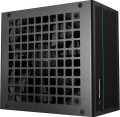Efficiency
Efficiency, in this case — the ratio of the power of the power supply (see "Power") to its power consumption. The higher the efficiency, the more efficient the power supply, the less energy it consumes from the network at the same output power, and the cheaper it is to operate. Efficiency may differ depending on the load; the characteristics can indicate both the minimum efficiency and its value at an average load (50%).
It should be noted that compliance with one or another level of 80PLUS efficiency directly depends on this indicator (for more details, see "Certificate").
Certification
The presence or absence of an 80+ certificate for the power supply. This certificate indicates high energy efficiency: to obtain it, the efficiency (see above) must be at least 80%, and in different modes (20%, 50% and 100% of the maximum load). There are several degrees of 80+:
—
80+. The original version of the certificate, assuming an efficiency of at least 82% (at least 85% for 50% load).
—
80+ White. The second name of the original 80+ certificate (see above).
—
80+ Bronze — efficiency not less than 85% (for half load — 88%).
—
80+ Silver — respectively 87% (90% for half load).
—
80+ Gold — 89% (92% for half load)
—
80+ Platinum — 90% (94% for half load).
—
80+ Titanium — 94% (96% for half load).
The power factor (see "PFC Type") must be at least 0.9 for the lower levels and at least 0.95 for the Platinum level. Also note that for redundant power used in server systems, the efficiency requirements are somewhat lower.
ATX12V version
A standard for power supplies that supplements the ATX specifications regarding power supply along the 12 V line. Introduced into use since the time of the Intel Pentium 4 processor. In the first series of the standard, the +5 V line was mainly used; from version 2.0, the +12 V line was introduced to fully power the components computer. Also in the second generation, a 24-pin power connector appeared, used in most modern motherboards.
MB/CPU power supply
The number and type of connectors provided in the PSU to power the motherboard or processor.
This parameter is written as the sum of several numbers, for example, "24+4". The first number in such an entry means the number of contacts in the connector for powering the motherboard; in the vast majority of cases, this is just 24, since modern motherboards use a 24-pin connector as standard. The second number describes the socket for powering the processor; most entry-level and mid-range CPUs use 4-pin power, but powerful chips may require 8-pin power. There can be several 4- or 8-pin connectors — based on powerful high consumption processors.
A separate case is the blocks of the "24 (20 + 4)" format. They have two separate plugs — 20 pin and 4 pin, which allows you to power both 24-pin motherboards and older 20-pin motherboards from such power supplies. At the same time, such models do not provide a separate power supply for CPU — it is powered only through the socket, and the 4-pin plug cannot be connected to any other components except the motherboard.
Now on the market there are PSUs with such power supply for the motherboard:
24 pin (20+4),
24+4 pin,
24+8(4+4) pin,
24+8+8(4+4) pin.
+3.3V
The maximum values of current and power that the PSU can provide on individual power lines.
The power line can be simply described as a pair of contacts for connecting a particular load; one of these contacts is “ground” (with zero voltage), and the second has a certain voltage with a plus or minus sign, this voltage corresponds to the voltage of the power line. In this paragraph, it is + 3.3V (such power is present in 20- and 24-pin connectors for motherboards, in SATA power connectors and some other types of connectors).
In general, power and currents are rather specific parameters that the average user rarely needs — mainly when connecting high-power components such as video cards, as well as when starting a PSU without a computer to power other electronics (for example, amateur radio stations). It is also worth mentioning that the sum of the maximum powers on all lines can be higher than the total output power of the PSU — this means that all lines cannot operate at full power at the same time. Accordingly, when the PSU is fully loaded, some of them will produce less power than the maximum possible.
+5V
The maximum current that the PSU is capable of issuing + 5V to the power line. For more information about power lines in general, see "+3.3V". Also note here that + 5V power, in addition to connectors for motherboards (for 20 and 24 pins), is also found in Molex and SATA plugs, as well as some other specific types of connectors.
+12V1
The maximum current that the PSU is capable of delivering to the first power line is + 12V.
For more information about power lines in general, see "+3.3V". Here it is worth mentioning that 12 V is the most popular voltage among computer power connectors. It is used in almost all such connectors (with a few exceptions), and some plugs (for example, additional PCI-E power for 6 or 8 connectors) use only 12-volt lines — and in the + 12V format. And the division of + 12V power into several separate lines is used for safety purposes — in order to reduce the current flowing through each individual wire, and thus prevent excessive load and overheating of the wiring. However, some manufacturers do not specify the maximum current for individual + 12V lines and give only a general value in the characteristics; in such cases, this number is indicated in this paragraph.
+5Vsb
The maximum current that the PSU is capable of issuing + 5Vsb to the power line.
For more information about power lines in general, see "+3.3V". Specifically, the + 5Vsb line is used to power the computer electronics in standby mode, when the main and only task of the system is to respond to pressing the power button. This does not require high power, so this figure rarely exceeds 3A.
+12V
The maximum power that the PSU is capable of delivering to the + 12V power line.
See "Maximum current and power" for details on power lines in general. Here it is worth mentioning that 12 V is the most popular voltage among computer power connectors. It is used in almost all such connectors (with a few exceptions), and some plugs (for example, additional PCI-E power for 6 or 8 connectors) use only 12-volt lines — and in the + 12V format. So this indicator is one of the most important characteristics of any PSU.
Note that many power supplies have several separate + 12V power lines. In such cases, the total power is indicated here, which, usually, is divided equally between the lines.

